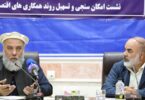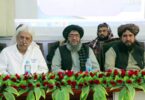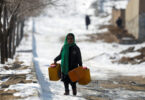KABUL (Khaama Press): Afghanistan is rich geography when it comes to mines and natural resources. Some of these mines are ready to be excavated while others are being mined illegally. So we can surely claim that this geography still possesses a vast amount of intact mines and natural resources which amount to nearly $3 trillion.
Based on a geological investigation conducted ten years ago in the US, it has been estimated that the total worth of Afghanistan’s mines and natural resources is USD1000 billion. The most important natural resources of Afghanistan are as follow, gold, silver, and plutonium, a vast amount of uranium, tantalum, bauxite, natural gas, salt, metal stone, copper, silver, chromium, tin, talc, sulfur, coal, barite, and zinc. Since there is a scarcity of these resources around the world, they have attracted special attention of the globe to Afghanistan.
The natural resources of Afghanistan are the biggest hope of the country to flourish its economy and to be free of economic reliance on other countries. The Afghan ministry of mines and petroleum has too estimated the mines and natural resources of Afghanistan worth $3 trillion. Officials in the ministry said that they have found 1400 spots possessing various types of natural resources such as natural gas, coal, salt, uranium, copper, gold, and silver.
Natural gas is mostly found in the northern provinces of Balkh, Shebirghan, and Saripol which has been estimated from 100 to 500 billion cubic meters. In the latest investigation conducted by NASA, there are over one hundred zones of oil and gas in Afghanistan. Most of the investigations regarding oil-rich regions have been conducted in five zones of Afghanistan namely two of them in the north of Amo River, one in Helmand province, one in Herat province, and one in Kato district of Paktika province.
Meanwhile, in the latest report of British Petroleum, the capacity of Afghanistan’s oil has been estimated to be from 250 to 300 barrels per day which enables Afghanistan to earn nine billion and one hundred million dollars annually from the resource. Officials in De Afghanistan Bank (central bank) say that Afghanistan needs from six up to seven billion dollars for its economic growth for which the natural resources are considered to be a good source of economic growth. In 2012, 150 thousand barrels of oil were to be excavated from the wells which would then be increased to 300 thousand barrels in 2013.
Meanwhile, oil resources have also been found in Herat, Shiberghan, Maimana, Kunduz, Taloqan, Saripol, and Helmand provinces. The coal resources of Afghanistan are estimated to be from 100 to 400 million tons. Coal resources have been confirmed to be in Baghlan province (Karkar mine), Kunduz province (Ash Pushta), Herat province (Karukh), and Balkh province (Dara-e-sof).
Gold mines have been excavated and used traditionally (washing gold). The method has been used in Darwaz district of Badakhshan province, Qala-e-Zal district, and the ravines of Raq and Dadung of Kunduz province. The gold mines have also been confirmed in Badakhshan, Kandahar, and Zabul provinces.
Silver mines: Badakhshan, Panjsher, Herat, Kandahar, and Ghorband of Parwan province are rich in silver and white gold.
Iron mines: these natural resources are situated in Baba mountains range close to Haji gak which is located 100-kilo meters to the west of Kabul and the second spot has been confirmed in the east of Bamyan province. This resource is considered to be one of the vital resources of Afghanistan and possesses a special spot in Asia in terms of importance and quality. On the whole, the ironstone of Afghanistan has been rather rare around the world which is mostly found in Kandahar, Faryab, Herat, Oruzgan, and Bamyan provinces.
Sulfur mines: Balkh, Badakhshan, and Nangarhar provinces are the richest provinces in terms of having sulfur mines.
Uranium mines: these resources can be found in the southwestern deserts of Afghanistan, Mir Daud Mountains of Herat province, and Shindand district of Kandahar province.
Granite mines: one can easily find the mines in Estalif, Charikar, Jawanmard-e-Qasab Mountain, Koh-e-Sorkhi Ghara Alaqi Kohdaman, Qarabagh Mountain, Zadran, Behsod, Oruzgan, Nahrain, and Shinwari.
Precious stones: the most precious stones of Afghanistan are Lapiz Luzi, Rubies, Emerald, garnet, and azure which can be found in Badakhshan province mostly. The paramount mines of azure and garnet can be found in Sarsang area located in the east of Kokcha river and 35 kilometers from south of Hazrat Saeed area. The azure of the latter has been estimated at 200 tons.
Construction stones: Jaghori district of Ghazni, Rigistan district of Kandahar, Ghorband district of Parwan, Gulran district of Herat, and Qorigh mountain of Kabul have marbles of various colors.
Salt mines: salt is being excavated from Taloqan mines and Gulafkan mines of Takhar province, Andkhoi of Faryab province, Namaksar of Herat, Moqor of Ghazni, and Mazar-e-sharif of Balkh province. The mines of Afghanistan have been considered equivalent to the independence of the country.
Along with the resources of gold, silver, and plutonium of Afghanistan, the country has a vast amount of metal stone, uranium, tantalum, bauxite, coal, natural gas and a considerable amount of copper. Since the afore-mentioned resources are rare in the world, Afghanistan has attracted international attention.
Badakhshan mines: Badakhshan is located in the northeast of Afghanistan bordering Tajikistan, China, and Pakistan. This province is a vast source of natural assets.
Sources equipping the Taliban: The Taliban have been benefiting from the excavation of mines illegally in Badakhshan province. The group is currently mining silver and gold in Afghanistan and was excavating the mines illegally and were extorting around the country. The Taliban are currently excavating gold in Raghistan and Kohistan districts, Yaftal-e-Bala district is full of rubies and the group is also earning from the district of Keran-o-Munjan. The fighters are currently controlling the area and are mining rubies there. As per the local residents of Badakhshan province, the Taliban are now excavating one ounce of gold in 180 different areas every day which is worth 18 thousand Afghanis.
Panjsher mines (under Afghan government control): Panjsher is a mountainous province located in the northeast of the capital Kabul and is one of the richest provinces of Afghanistan in terms of natural resources. The natural resources of this province include precious and semi-precious stones, metal mines, mines of marbles, and mines of construction materials. Panjsher province has a vast amount of resources in its soil which have been under the control of the Afghan government.
Baghlan mines (under Taliban’s control): Baghlan is one of the provinces which has a vast amount of natural resources in its capital Polkhumri and other districts. The most well-known mines of the province are, the mines of Karkar and Dodkash, coal mine of Chenarak and Sheen Dara, coal mine of Alogak, mine of Tala-Barfak, gold mine, lead mine, stucco mine, and granite mine which are under the Taliban’s control for the time being.
Bamyan mines (under Afghan government control): Bamyan province is rich in different mines such as the iron mine of Hajigak, the iron mine of Seya Dara, the coal mine, and mines of precious stones. The center and different districts of Bamyan province are full of stone mines, coal mines, precious stones, mines of copper, mines of sulfur, mine of lead, mines quicksilver, and mines of stucco which are under the control of the Afghan government.
Helmand mines (under Taliban’s control): the southwestern province of Helmand borders Pakistan in the south, Daikundi, Kandahar, and Oruzgan provinces in the east, and Farah province in the west. Based on the geological survey conducted by local officials, Helmand province has a vast amount of mines and natural resources such as, muscovite in Balishang, decorating stones in Malek Dokan and Arbo, quicksilver in Baghlan, marbles, mineral water in Kajaki, and pegmatite in Sangwal which are under the control of Taliban currently.
Herat mines (under Taliban’s control): As per the geological surveys conducted about the Herat province, it has the mines of iron in Tagab, Pod mountain, and Palangsor, mines of copper in Shaida, Simkoh, tinny in Fostak, gold in Enjeel, and mines of bismuth.
Badghis mines (under Taliban’s control): this province is also one of the provinces which possesses different kinds of natural resources, such as copper in the Ahan Kashan area, stucco in Daralaman, and the water of nitrogen in Chashme Nik.
Faryab mines: as per the survey of local bodies in Faryab province, this province also has a vast amount of natural resources such as iron in Qiji, copper in Se Koh, salt in Dawlat Abad district and the central city of Maimana, sulfur in Katakan, and coal in Safid Barfak.
Takhar mine: gold, quartz, slat, coal, and mineral water are the natural resources that can vastly be found in different regions of Takhar province.
Jawzjan mines: Jawzjan province which borders Turkmenistan and Tajikistan is a rich province of Afghanistan when it comes to natural resources. Based on the local geological surveys, Jawzjan has a vast amount of natural gas, copper, raw materials of cement and coal.
Khost mines: as per the local geological surveys conducted in the province, Khost possesses the natural resources of chromite, quartz, lead, construction material, and others in different regions.
Paktika mines: Paktika province is also home to a good amount of chromite, talc, magnetite, coal, and construction materials.






